Nov. 2001 Vol. 222 No. 11
Feature Article
|
NATURAL GAS:
PART 8: MONETIZING STRANDED GAS
How operators will bring 'worthless' gas to market
The complexity of FT/GTL processes combined with the memory of the recent oil price crash have made operators cautious. But as process knowledge and costs are understood, GTL plant construction is moving ahead to monetize stranded gas
Perry A. Fischer, Engineering Editor
"Stranded gas" is an all-encompassing term. For the purpose of this article, stranded gas is any hydrocarbon-based gas that is uneconomic to deliver to market. This includes associated and flared/vented gas, and gas that is re-injected purely for regulatory compliance rather than for reservoir-pressure maintenance. Some of the factors that determine when a pipeline is profitable include resource volume, transport route, regulatory environment, market size and demand growth. Sometimes, excess reserves can be considered stranded, since these would require a paltry delivery rate to avoid oversupply of local markets. Negative economics can also be due to technical complexity or expense associated with recovering/gathering the gas. Stranded gas is essentially gas that is wasted or unused. Whenever one thinks of stranded gas, the primary goal is an alternative to pipeline transport.
A recent study by Zeus Development Corp. and IHS Energy identified some 450 Tcfg stranded in fields greater than 50 Bcf that can be gathered and produced for less than $0.50/MMBtu.1 Many larger fields can produce gas even cheaper. Recent price spikes suggest that in many markets, 10-year contracts could be secured for more than $3.5 to $4/MMBtu, which broadens the economic viability of smaller fields. Worldwide proved gas reserves are estimated at 5,226 Tcf.2
Depending on how one defines "reserves" and "stranded," estimates of stranded gas vary from 900 to 9,000 Tcf.3,4 The latter number would convert to about 900 billion bbl of synthetic hydrocarbon liquids. Although such a quantity seems improbable to achieve, any reasonable fraction of this amount is significant and, therefore, worth investigating. This article reviews the current status of technologies that industry is using to bring this otherwise unused energy to markets. These technologies include gas conversion to LNG, gas to liquids (GTL), gas to hydrates and gas to electricity.
LNG
The conventional solution is gas compression/cryogenic cooling to produce liquefied natural gas. Worldwide LNG supply has more than doubled during the last 20 years, to nearly 6 Tcf/yr. The liquefied gas accounts for 4% of world gas consumption, and 23% of world gas exports.5 With new LNG export facilities in Trinidad, Qatar and Nigeria, plus proposed or developing projects in Australia, Norway, Angola, Egypt, Peru, Venezuela, Iran and Russia, LNG production could again double within a decade. Floating LNG plants have been proposed to produce stranded offshore reserves. LNG will likely play an increasing role in development of giant gas fields, since most countries – especially net oil importers – are keen on developing their gas reserves, however stranded, for greater energy independence and extending domestic oil reserves where applicable, as well as for environmental reasons.
Conventional LNG production requires minimum reserves of several Tcf, investment of more than $1 billion and long-term (15 year+) contracts, although in some cases these have been getting shorter. It also requires insulated LNG supertankers and specialized offloading terminals. Nevertheless, LNG will figure prominently in monetizing stranded gas. Costs to liquefy gas and construct LNG tankers fell 30% over the past two decades.6 One report cites a 60% cost reduction since 1989 for constructing the liquefaction plant alone, and incremental increases in efficiency and capital-cost reduction will undoubtedly continue.1 Further cost savings can be achieved by combining LNG with GTL facilities, and there are several plans / studies underway to do just that in Nigeria, Egypt, Qatar, Australia and Iran.
Small-scale LNG plants are under development and could have considerable impact on smaller volumes of stranded gas, which, cumulatively, are enormous. These units are increasingly being used for peak shaving at power plants and at LNG-vehicle fueling stations. It is likely that these technologies will transfer to applications in monetizing stranded-gas as designs / efficiencies improve and government regulation increases. Turbo-expansion plants can take advantage of wasted cooling due to expansion from pressure drops, whether at "city gates" or at the wellhead, and Stirling Cycle cryogenic plants are being considered. Praxair is developing a novel thermo-acoustic engine for cryogenic use that has no moving parts. SINTEF Energy Research and ABB Gas Technology are testing a small-scale gas liquefaction system that uses conventional technology and a multicomponent refrigerant. CryoFuel Systems is installing two 5,000-LNG gal/day units for stranded-gas wellsite use in Texas and California. There are many more examples.
GTL
GTL is not new. Creating methane from hydrogen and carbon monoxide was first achieved by Paul Sabatier and Jean Senderens in 1902. Franz Fischer and Hans Tropsch further developed the synthesis to mainly oxygenated products and liquid hydrocarbons in 1923. GTL is an application of the basic Fischer-Tropsch (FT) process, where synthesis gas (or syngas, H+CO) is reacted in the presence of an iron or cobalt catalyst. End products are determined by the length of the hydrocarbon chain which, in turn, is determined by catalyst selectivity and reaction conditions, Fig 1. Possible end products include kerosine, naphtha, methanol, dimethyl ether, alcohols, waxes, synthetic diesel and gasoline, with water or carbon dioxide produced as a byproduct. Natural gas or coal can be the raw feedstock.
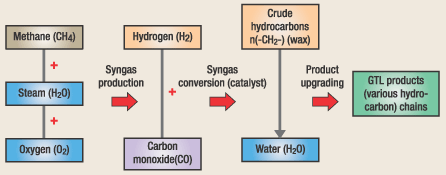 |
Fig. 1. Three basic steps are in the FT process: 1) creation of synthesis gas; 2) reaction in FT process over a catalyst to form various hydrocarbon chains; 3) raw products upgrading. The hydrocarbons are synthesized by a chain-growth process, with chain length determined by catalyst selectivity and reaction conditions.
|
|
Germany used the FT process during the Second World War to produce fuel from coal. South Africa began using the process, first, in 1955 using coal as feedstock, and later in response to apartheid-related sanctions during the 1980s. Mobil’s zeolite catalyst (ZSM-5) enabled a natural gas to gasoline project that operated from 1986 to 1997 in Motunui, New Zealand, producing about 14,000 bpd. Gas-to-gasoline economics mirrored oil-price volatility. The plant currently produces methanol and is owned by Methanex.
Hundreds of modifications and patents have been applied to this complex, energy-intensive process, and further developments continue to the present day. A discussion of all variations on the basic process is well beyond the scope of this article, but most recent modifications generally involve lowering capital expenditures and the overall energy required for processing, especially through the use of proprietary catalysts and the manner in which oxygen is added to the system. For the interested reader, nearly 200 technical papers can be found at: www.fischer-tropsch.org.
GTL economics. Operating costs are coming down steadily, and every year there seems to be another company or two that has patented a new, cheaper process. Add to this the volatile nature of oil prices, and it is understandable why operators have been slow to act.
Various reports say GTL is profitable in the $15 to $25 per bbl oil (Brent) range, with most favoring the middle of that range. Shell has stated that a stand-alone SMDS (Shell’s Middle Distillate Synthesis) project in the Middle East would be financially attractive with crude prices at about $15/bbl.7 To get closer to the $15/bbl mark, it is important that the gas supply is nearly free, or at least below $0.50/MMBtu.
Capital expenditures range between $50,000 and $20,000/bbl of capacity, with recent advances pointing toward the lower price. A U.S. DOE study concluded that GTL would be economically comparable to LNG with regard to Alaska North Slope gas. As for Australia, its government’s GTL Task Force recently wrote "It seems likely that a GTL plant will not go ahead unless there is some form of government intervention that lowers project costs, at least in the short term."8 Determination of profitability depends on plant location and its size; products to be produced and their markets and distances; method of oxygenation; choice of catalyst; gas-supply agreements; government taxes and political stability of the region.
Adjunct technology could have a significant impact on costs, such as ceramic membranes that selectively extract oxygen from air. Various U.S., Australian and other researchers – both governmental and private – have been developing these ceramics for the past five years or so, and they have made good progress. Infusing oxygen into the syngas-making process is essential; pure oxygen boosts efficiency, but cryogenic production is expensive. Syntroleum uses compressed ambient air as an oxygen source. The Ionic Transport Membrane Syngas Project, a 12-member industry, university and U.S. National Laboratory consortium, encouraged by the ceramic membrane results, began an eight-year project in 1998 to develop ceramic membrane technology that could allow syngas production – a major expense in GTL – at 25% less cost.
Besides the financial incentive to monetize otherwise worthless gas, the process has received added impetus in recent years, especially with regard to diesel fuel. There are increasing restrictions on gas flaring / venting. Also, the trend for industrialized nations to reduce sulfur content in fuels is likely to accelerate, if recent laws such as those enacted in the U.S. are any indication.
Starting in 2006, the U.S. EPA mandates that diesel sulfur content be reduced to 15 ppm from the current 500 ppm maximum. Europe wants it at 10 ppm. Other stringent standards require reducing particulate matter by 90% and lowering NOx emissions; these begin in 2007. In addition, the U.S. recently designated domestically produced GTL fuels derived from natural gas as alternative fuels, as defined under its 1992 Energy Policy Act. The high-quality diesel is also suitable for fuel cells. Finally, GTL presents a method – however long term – for oil-importing nations with sufficient domestic gas / coal reserves to lessen their dependence on imported oil, as is the case with South Africa today.
Fortunately, diesel from FT synthesis has improved properties: It is virtually sulfur free; has higher cetane levels; is cleaner burning and non-aromatic, to name a few, Fig. 2. Industry will have to find solutions to sulfur-reduction mandates independent of GTL diesel, since GTL-diesel volumes will be insufficient for widespread use as a sulfur-reducing blending agent (although Shell has sold well over a million gallons of GTL middle distillates that were blended with conventional, higher-sulfur diesel).9 However, its high cetane (70 vs. 50 for regular diesel) and non-aromatic content make it desirable as blendstock for other purposes. On the negative side, unaltered GTL diesel has poor cold-weather properties. All of this means that it is questionable whether GTL diesel will command a price premium. A recent estimate put the premium range at $0 to $2.50 per bbl.8
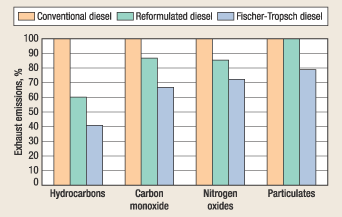 |
Fig. 2. Tests on Sasol Slurry Phase Distillate diesel at the Southwest Research Institute in San Antonio, Texas, demonstrating exhaust-emissions improvements. Comparisons use conventional diesel as baseline (100%). Results show reductions in: unburned hydrocarbons (59%); carbon monoxide (33%); NOx (28%); and particulates (21%).
|
|
GTL production. Other than minor test-facility volumes, three companies account for current world production of about 200,000 bpd of synthetic liquid fuels from GTL processes. Two South African companies currently use the FT process to produce fuels, waxes and other products: Sasol produces about 154,000 bpd of liquid fuels from coal feedstock (although it is converting some feed capacity to natural gas), while state-firm Mossgas produces roughly 30,000 bpd from offshore gas. Shell makes about 12,000 bpd at its Bintulu plant in Sarawak, Indonesia, from natural gas. Projections of future production vary radically, but projects in various stages of planning, if completed, would increase GTL production to between 1 and 2 million bpd within 15 years. Worldwide demand for middle distillates is about 20 MMbpd.10
Projects. Most major oil companies have plans to build GTL commercial or pilot plants. Counting ongoing and future GTL projects is difficult, partly because their status and number changes (usually upward) so often. If one includes all pilots, projects, proposals, feasibility and Front End Engineering Design (FEED) studies, there are roughly 40 of these worldwide,11 with about 15 GTL plants planned for construction within 8 – 10 years. A partial listing follows:
- With an estimated 130 Tcf of uncommitted gas off its northern coast, Australia has seen several proposed GTL projects. These include Sasol Chevron’s specialty fuels and Shell’s specialty fuels plants, and Japan DME Ltd.’s dimethyl ether / methanol plant. Syntroleum’s Sweetwater plant at Burrup Peninsula has a $600 million engineering, procurement and construction contract with German-based Tessag. The plant’s operating capacity will be about 11,000 bpd of specialty products. The project is now seeking financing.
- Syntroleum and Marathon Oil will build a 70-bbl/day GTL demonstrator project at the Port of Catoosa near Tulsa, Oklahoma, under a U.S. DOE program; DOE will fund $16 million of the $36 million cost. A request for proposals has been issued for construction of the project, and contracts will be awarded by year-end. Some equipment will be reused from Syntroleum’s successful GTL pilot plant (Fig. 3.) at BP’s Cherry Point, Washington, refinery.
- Syntroleum, Chile’s ENAP and Advantage Resources Int’l. will conduct a project assessment for a 10,000 bpd synthetic fuels plant. If constructed, it would be located at the ENAP-owned Cabo Negro Industrial Park near Punta Arenas, Chile. Syntroleum Corp. has been successful at licensing its technology to Arco (BP), Enron, Ivanhoe Energy, Kerr-McGee, Marathon, Repsol-YPF, Texaco and the Commonwealth of Australia.
- To eliminate 300 MMcfd of flared gas in Nigeria, Chevron, NNPC and Sasol intend to build a 30,000 bpd GTL/naphtha plant in Escravos, Nigeria. It appears that this project will proceed since joint venture and FEED contracts have been signed. This is part of a larger three-phase project that already processes 200 MMcfgd conventionally. Completion is slated for 2005.
- Qatar Petroleum and Sasol have signed joint venture and FEED agreements for its $800-million GTL plant at Ras Laffan Industrial City, Qatar. The FEED work should be completed by mid-2002, followed by a five-month bidding phase for an engineering procurement and construction contract. Scheduled start up is in 2005. The plant will produce 34,000 bpd of synthetic fuel / naptha. Also in Qatar, ExxonMobil and Qatar Petroleum recently signed a letter of intent for a feasibility study for a 90,000-bpd GTL facility.
- Mossgas will build a new plant for production of 70,000 t/yr of specialty fuels and distillates. The facility will be located at Mossel Bay, South Africa, and is scheduled for completion by late 2002.
- Shell and the Egyptian General Petroleum Corp. entered into a Development Protocol for a 75,000-bpd synthetic fuels plant using the SMDS process and at least one LNG train. If constructed, the plant could be located at West Demiatta on the Mediterranean coast and be operational by mid-2004 for LNG and late 2005 for SMDS. Shell is also surveying the feasibility of GTL plants in Indonesia, Malaysia, Iran, Argentina and Trinidad. The company has said that it intends to build at least four 75,000-bpd plants (requiring 600-MMcfdg supply each) at a combined cost of $6 billion.
- An MOU was recently signed between Rentech and GTL Bolivia. Once a license agreement is signed, GTLB plans to immediately begin design of a 10,000-bpd GTL plant to be located in Bolivia. The project has been on hold while awaiting resolution of some legislative issues in Bolivia concerning its hydrocarbons law. Under terms of the agreement, GTLB could increase the plant’s capacity up to 50,000 bpd.
- Rentech is conducting several studies in Sweden, Brazil, Indonesia (Pertamina) and with the Wyoming Business Council. The company is beginning the second phase of a study for its GTL process to convert industrial off-gas, which should be completed by year-end.
- Conoco says its team of 80 scientists and engineers have been researching gas-conversion technologies since 1997. The team has manufactured and tested a variety of reactor configurations and more than 4,500 catalysts. Conoco plans to build a $75-million demonstration plant in Ponca City, Oklahoma, as part of a major initiative to commercialize the company’s GTL technology.
- BP is constructing a GTL test facility at Nikiski, Alaska, that will use about 3 MMcfg to produce about 300 bpd of synthetic crude. The facility is scheduled to begin operations during mid-2002. (In conjunction, natural gas will power a Siemens Westinghouse solid oxide fuel cell that will generate 250 kW of electricity – enough for 50 homes.)
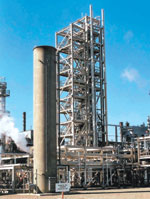 |
| |
Fig. 3. Syntroleum’s successful GTL pilot plant at BP’s refinery Cherry Point, Washington.
|
|
Gas to Hydrate
Gas hydrates are clathrates (molecular "cages") that trap gas within a water-ice lattice. One usually thinks of hydrates as a production problem to be avoided. The roughly 160:1 gas compression ratio within the lattice could allow economic transportation of gas in this form, although the water fraction is 85% by weight. Two promising ventures that envision using hydrates to transport stranded gas are noted below.
BG’s gas to solids / slurry. BG Group has been working on gas to solids technology since 1993. More than $5 million has been spent on its development. It has been operating a 1-t/day pilot plant since 1997 and plans to have a commercial operation by 2006. The technology has recently been undertaken for BG by AdvanticaTechnologies Ltd. Although solid (snow-like) hydrate has been produced, the focus now is on hydrate slurry production for associated gas.
Conceptually, hydrate slurry production is simply mixing chilled water and gas. In practice, processed gas is fed to a hydrate production plant, where a series of reactors convert it into hydrate slurry. Each reactor further concentrates the hydrate slurry. It is then stored and eventually offloaded onto a transport vessel, Fig 4. At the receiving terminal, the hydrate is dissociated and the gas can be used as desired.
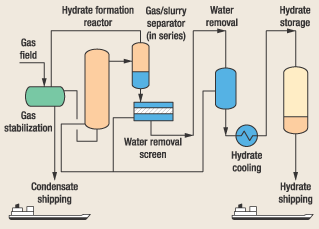 |
Fig. 4. Schematic of BG’s gas hydrate slurry transport method for monetizing offshore (especially associated) gas.
|
|
Norway’s gas to slurry. Earlier work by Statoil, Aker and others on Natural Gas Hydrate (NGH) transport dates back to 1990. A consortium-sponsored research project comprising six oil companies, Aker Technology, the Norwegian University of Science and Technology, and the Research Council of Norway has been studying NGH transport since 1997. Current feasibility studies indicate that hydrate transport for moderate-scale and long-distance (3,800 mi) transport would cost about 24% less than conventional LNG technology (compared to standard single train, 400 MMcfd), see table.12 The economics remain positive for shorter distances as well.
| |
Comparison of capital cost of NGH and LNG chains for 400 MMcfd production and 3,800-mi transport. |
|
| |
Chain
|
LNG
|
NGH
|
Difference
|
|
| |
Production |
1,220 (51%) |
792 (44%) |
428 (35%) |
|
| |
Carriers |
750 (32%) |
704 (39%) |
46 (6%) |
|
| |
Regasification |
400 (17%) |
317 (17%) |
83 (21%) |
|
|
|
|
| |
Total |
2,370 (100%) |
1,813 (100%) |
557 (24%) |
|
| |
Millions of dollars (Borrehaug and Gudmundsson 1996). |
|
|
|
|
Two methods were studied: A dry hydrate for transport from dry (or nearly so) gas reservoirs and a slurried hydrate for transport of associated gas from FPSOs. In both cases, the water that forms the hydrate is recycled, eliminating environmental concerns. In some cases, the economics indicate that a gas and oil slurry could be piped in a two-phase flow to land and then be separated, the gas portion hydrated and transported to markets.
CAPEX and OPEX cost analysis for an FPSO have been estimated based on additional costs to convert an FPSO.13 Base situation was 100,000 bopd with a GOR of 100, yielding 56 MMcfgd. Fuel gas was assumed at 10% of total gas rate. Therefore, 51 MMcfgd was converted to hydrate. Based on 20-year project life and 9% interest on capital, for a transport distance of 1,070 mi, the cost was $2.75 per MMBtu. There is a growing need for non-pipeline transport of offshore gas, especially when it is associated. When regulation prevents flaring and there is no need (reservoir pressure maintenance) for re-injection, the gas has a negative value.
Other Technologies
For completeness, six more examples of monetizing stranded gas will be discussed.
Microturbines for power generation. Each year, over 4 Tcf of gas is flared worldwide. Microturbines are a relatively new solution, particularly the newer types that can use untreated flare gas that contains significant amounts of H2S and CO2. They are small enough (refrigerator size) so that a unit can be easily added / removed as associated-gas production warrants. Some of these can also recover waste heat, making them micro-cogenerators.
This increasing use is furthered by both financial incentive to monetize small amounts of wasted gas and regulatory mandates. Canada is a good example. It has an aggressive program to reduce flaring. The Alberta provincial government suspended royalties on waste natural gas when used for electrical generation. This helped spur a number of developments during the past two years. Mercury Electric Corp. installed 39 Honeywell 75-kW turbogenerators at many oil-production facilities throughout Alberta in 2000; and 2001 looks to be another busy year. In November 2000, Mercury installed its second Garrett turbine at a Grand Prairie oil-production site, using flare gas to produce 435 kW of electricity.
PanCanadian Petroleum deployed three 28-kW Capstone mini-turbines at its Pelican Lake oilfield. The turbines burn about 27 Mcfd of waste gas, generating up to 84 kW of power for onsite use.
Worldwide, this is a growth industry, with government regulations adding impetus. Wherever flare gas is located near power lines or there is a local use for power, microturbines can fill the need – and make operators extra cash as well.
Landfill gas (LFG). For 50- to 150-acre landfills, the average LFG flowrate is 2.5 MMcfgd. Landfill gas is utilized in various ways, but two companies have successfully demonstrated interesting technologies for monetizing landfill gas. At Lopez Canyon landfill in northern Los Angeles County, 50 microturbines were installed near the gas-flaring stacks in March of this year, Fig 5. The City of Los Angeles unanimously approved a $4 million purchase of another 141 microturbine power systems. Collectively, once installed at various facilities, the distributed generation systems will have a 4-MW capacity – enough electricity for about 4,000 homes.
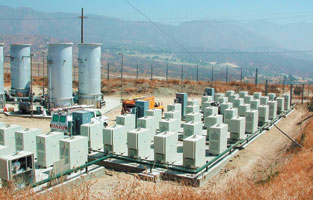 |
Fig. 5. Microturbines convert small gas volumes from flare / vented and other sources into electricity. Small units allow for appropriate sizing as gas supply volumes change. Shown is a new landfill gas system at Los Angeles’ Lopez Canyon landfill, where 50 Capstone microturbines convert landfill gas into 1.5 MW of electricity – enough to power about 1,500 homes.
|
|
Landfill LNG. The trick to handling LFG is separating the CO2 from the methane and dealing with the lack of positive gas pressure. Monroe, Washington-based CryoFuel Systems reported that their Hartland landfill unit produced LNG from LFG a year ago. The unit also produced a pure stream of CO2. Since November 2000, the system has operated on an interim basis for up to two week periods and produced nearly pure streams of LNG and CO2.
Compressed Natural Gas (CNG). Two new types of CNG transport are being promoted by their respective companies and are discussed below.
VOTRANS is a new type of CNG marine-transport technology from EnerSea Transport, L.L.C. Its engineering studies indicate that it can move up to 2 Bcfg per ship, over distances up to 4,000 mi at significantly lower total costs than LNG. The company says that Paragon Engineering, Alan C. McLure Associates, and Groppe, Long & Littell have confirmed technical viability and indicate that gas transported by this means could sell into U.S. markets for substantially less than $3.00/Mcfg.
The technology comprises large-diameter pipe structures manifolded together in tiers, essentially a sea-going pipeline. To maintain temperature, the pipe structures are contained within a nitrogen filled, insulated chamber. It can store CNG more efficiently at significantly lower compression (~40% compared to LNG), increase vessel capacities, reduce costs and transport both lean and rich gas.
The company says that total capital costs are less than LNG, with required terminal facilities making up less than 15% of its total capital cost, compared with more than 60% for LNG. Finally, VOTRANS minimizes gas losses during processing and transport to less than 7%, compared to as much as 20% for LNG. The technology has completed HAZIDs with Class Societies American Bureau of Shipping (ABS) and Det Norske Veritas (DNV). The company plans to complete regulatory approval in principle in 2002 and could begin service by mid 2004.
Coselle CNG technology is from Cran & Stenning Technology Inc. A joint industry project comprising 10 multinational industry partners (mostly oil companies) has been funding research and will soon begin a pilot project to ship gas from Venezuela or Trinidad to Curacao by Coselle CNG barge. The system uses conventional, 10.6-mi long, 6-in. dia, 1/4-in. WT line pipe in large coils (coselles). Such a CNG carrier may have 108 coselles with a 330-MMcfg capacity. Stored gas temperature is 50°F at 3,000 psi. ABS and DNV have concluded that a Coselle CNG Carrier is "at least as safe as other gas carriers."
These ships can be loaded at relatively simple marine facilities, including offshore buoy moorings, through flexible hoses connected to onshore or on-platform compressor stations. Small, otherwise stranded, gas projects can be accommodated by Coselle CNG barges. Optimal conditions for these delivery systems are: marine distances less than 2,000 mi; long / difficult pipeline routes; project economics that benefit from the scalability the system; and projects that require offshore gas loading / offloading system.
Non-FT GTL. Finally, Synfuels Int’l. says that it has started and operated a new type of GTL system. During operation, the pilot plant successfully converted natural gas into a "combustible hydrocarbon liquid." The company says it is the world’s first operational, non-FT GTL. "The process is much simpler than existing technologies, does not require syngas, and does not use oxygen except in power generation. Researchers at 'a leading U.S. university' developed the process. It does not burn natural gas and the liquid product is a clean-burning, sulfur-free fuel."
Conclusion
In addition to making money, there are many additional drivers for monetizing stranded gas. These include regulatory, environmental and, for oil-importing nations with sufficient stranded reserves, a way to lessen dependence on imported oil. Every form of gas, including associated / flared, industrial off-gas and landfill gas is being intensely scrutinized for all of these reasons.
In situ methane hydrate (oceanic and permafrost) was not discussed here, because it is not a bona fide resource – yet. Although sufficient data now exist to substantiate a reasonable chance of locating these clathrate deposits, the ability to produce them remains unknown. However, a consortium of countries and operators will begin the world’s first controlled production testing of hydrates in early 2002 in the McKenzie Delta region of northwestern Canada.
The future of GTL depends on its profitability. Cost concerns include plant construction and operating processes, as well as the price of oil as a competitive benchmark. GTL’s complexity and energy intensity, together with new computer-modeling techniques, make the process ripe for dramatic cost savings, experimentation and, unfortunately, investor-targeted hype. Operators would be wise to base GTL economics on a zero premium for its fuels, and then be pleasantly surprised if a premium materializes. Economies of scale, synergies to lower CAPEX and OPEX – such as co-location with LNG facilities and nearly free feedstock – will help ensure profitability. On the operator side, it appears that Shell is convinced the economics are sound and, together with Chevron Sasol and Syntroleum, is leading the way in GTL. The future of technologies that monetize stranded gas is secure, it’s only the development pace that is unknown. 
Acknowledgment
The author thanks John Ford at Syntroleum for assistance in obtaining information about this article.
Literature Cited
1 "2001 world LNG/GTL review," Zeus Development Corp., 2001.
2 "World Reserves," World Oil, August 2001.
3 Petroconsultants-MIA and Zeus International, Remote Gas Development Strategies, HIS Energy Services, September 1999.
4 Agee, M., "Taking GTL conversion offshore," OTC 10762, Offshore Technology Conference, May 3 – 6, 1999.
5 Energies, No. 44, p. 25, TotalFinaElf, Spring 2001.
6 Beale, Jeff, "In depth," at: www.onlinemariner.com, September 28, 2001.
7 Bodewes, Theo, "From gas to liquid gold," Interview, at: www.shell.me.com/aug1998/profile2.
8 Gaffney Cline and Associates, "GTL discussion paper," Prepared for the Gas to Liquids Taskforce, Australian Dept. of Industry, Science & Resources, Commonwealth of Australia, June 2001.
9 California Energy Commission, Website page: www.energy.ca.gov/ afvs/synthetic_diesel.html
10 Arthur D. Little, "Gas to liquids conversion," 1998.
11 Dennis Yakobson, "Economic potential of fischer-tropsch technologies," London, UK, Speech, June 28 – 29, 2001. See also www.rentechinc.com/GlobalGTLSummit2001.pdf .
12 Gudmundsson, J. S., and M. Mork, "Stranded gas to hydrate for storage and transport," Int’l. Gas Research Conference, Amsterdam, November 5 – 8, 2001.
13 Hove, et al., "NGT technology: A promising concept for gas storage and transport," Gas to Liquids II Conference, London, September 22 – 23, 1999.
 |
 |
Part 1: Exploration Methods |
 |
Part 2: North America Outlook |
 |
Part 3: HP/HT Drilling and Completions |
 |
Part 4: Tight Formation Stimulation |
|
Part 5: Sour Gas Handling |
 |
Part 6: Anomalously pressured zones |
 |
Part 7: Gathering and Compression |
|







